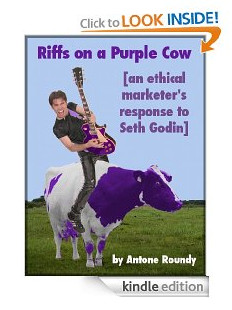When you purchase through links on our site, we may earn an affiliate commission (details)
“Dime Sale” Lessons and Ruminations
by Antone Roundy | 2 Comments | Marketing
I ran my first "dime sale" last week, and thought I'd share a few lessons and ideas I picked up from the experience.
I'd originally planned to have it start at noon US Central time and run 24 hours. That made sense because the majority of my customers are in the US, and that would be a reasonable time in pretty much any US timezone (maybe not Hawaii...).
So I wrote two emails to my list to announce it -- one to go out the night before, and a reminder an hour before. It's probably a good thing I didn't just send one an hour before, because I got a response to the first email from someone in Australia who didn't want to stay up till midnight to get in on the sale.
That sparked the idea of splitting the sale into two 12-hour sales -- one starting at noon and the other at midnight.
The idea had pros and cons:
- It might get me more sale by being more convenient for people on the other side of the world.
- But it might reduce sales by giving people on this side of the world a reason to procrastinate buying and possibly forget.
- But it might increase sales by giving people who arrived too late to get a price they were willing to pay another chance to buy at a lower price.
In any case, one good thing did come out of it: Andy Beard tweeted about it and drummed up a little extra traffic for me.
Honestly, I had mixed feelings about that tweet going out -- I wasn't quite sure how well my server would hold up under the traffic (it wasn't a problem). Here's the next lesson: if you're doing something that's going to bring lots of traffic to your site all at once, find ways to lighten and spread the load out as much as possible.
One thing I did was use a countdown script that was able to display the order form when the sale started rather than redirecting to it. In other words, the order form was on the page but hidden, and when the time came for the sale to start, it used JavaScript to make it visible.
In my emails and on the page, I told people this is what would happen and warned them not to refresh the page, because if the server got bogged down, they might not get in at the starting price. So people arrived at various times before the start of the sale rather than everyone loading the page right as the sale started.
Of course, a ton of people click the "Buy" button at almost exactly the same time, but it turns out my server handled that fine (other than a little glitch in my checkout system that didn't cause too much trouble, but that's a story for another day).
On the download page, as I always do, I promoted my affiliate program. I got 4 times as many new affiliate signups on the first day of the sale than I've ever gotten in a single day before. Presumably these are customers who are going to be a little extra happy because they got a great price on the product, so I'm hoping for some enthusiastic promoters.
One of the nicest things about the sale (along with the money it brought in, of course), has been getting emails from people who were so excited to get such a great deal on the product.
I've noticed from my sales numbers, refund rates (yes, I'm sure some people are ripping me off, but I don't let it bother me much), and feedback I've received over the past 8 months or so that not everyone is having an easy time with the economy. So it was nice to be able to give a little extra and get a little extra back (in volume if not in unit price) at the same time.





September 3rd, 2009 at 11:14 am
I've seen dime sale scripts that start at a low price when a visitor first arrives on a page (no matter when that is), and increase it at fixed intervals.
The advantage of this approach is that you can run your dime sale constantly forever as traffic trickles in over time.
But there are many disadvantages, including:
1) There's not a good "reason why" the price is going up. With the kind of dime sale described in the post above, customers are racing with each other -- the price goes up because somebody else beat you to it.
2) With a fixed interval dime sale, the starting price may be perceived as the "real" price, and as the price goes up, you're getting penalized for waiting. In a "race" dime sale, the starting price is the "great discount" price, and as it goes up, it's still a discount.
3) Many people will know that they can get the initial price by reloading the page (possibly after deleting a cookie). This makes them look more gimmicky.
4) "Race" dime sales create social proof. If you're seeing the offer at $14.00, somebody must have paid $13.90 (or whatever the previous price was), so the product is surely worth a dime more than that, right?
5) Race dime sales have a whole different feel to them -- it's not just you sitting there on the page all alone deciding whether or not to buy -- you're part of a crowd knocking down the door to get the best deal. It's more fun, more exciting, more social -- there's a sense of accomplishment if you get a great deal.
November 19th, 2009 at 10:34 am
Thanks for your great insight into Dime sales. You have inspired me to give them a try!
I agree not everyone is having an easy time with the economy and this is a great way to offer people a good deal.